The history of African American politics in North Omaha first emerged in the 1870s. It has fluctuated a lot since then, with some periods of a lot of activity (1890s, 1910s, 1950s, 1970s, and 2010s) and other periods with no apparent activity.
This is just a collected history. Someone needs to interview people in and associated with North Omaha’s African American community in order to find the real details behind all of the following events. This type of process will also bring out the details that a broad scan like this cannot show.

This article isn’t just about party politics, or local politics. Instead, this list includes political, social, economic and cultural developments that affected African Americans and all Omahans.
I. Black Politics in Early Omaha (1854-1879)

- 1854: Omaha founded. The first Black person was reported to live in the city in 1856.
- 1869: Edwin Overall leads a fight to end the segregation in Omaha schools, and in 1869 the system ended.
- 1869: The first African American to hold a government job in Nebraska is Overall when he was appointed as the general delivery clerk for the post office. He was the first black mail carrier in the state and the only Black man to hold a government position in Nebraska until the 1880s. He worked for the post office until he died in 1901.
- 1871: Overall organized the Progressive Age Association, the first literary society in Omaha. An important gathering place for Omaha’s African American community, members included Dr. W. H. C. Stephenson, Dr. Matthew O. Ricketts, Abraham W. Parker, W. H. Washington, Rev. R. Ricketts, E. S. Clellans, J. Johnson, C. C. Cary, and Overall’s wife.
- 1876: W.H.C. Stephenson, Edwin R. Overall, William R. Gamble, Emmanuel S. Clenlans, Edwin Overall, and Rev W. H. Wilson organized the Nebraska State Convention of Colored Men. The convention met to discuss lynching and to select delegates for a similar national convention.
II. 20 Years of Progress: 1879-1899
- 1880: African American Republicans met on August 18 in North Omaha, and elected W.H.C. Stephenson to be among the delegates sent to the Nebraska Republican Convention.
- 1880: On August 30, W. H. C. Stephenson, James O. Adams, Edwin R. Overall, John R. Simpson, and Peter Williams organized a Nebraska State Convention of Colored Americans.
- 1880:Matthew Ricketts was admitted to the Omaha Medical College, which became the University of Nebraska Medical Center.
- 1880: One of Edwin Overall‘s daughters was a candidate for teacher in the Omaha Public Schools, but was denied by the board due to her race.
- 1884: Matthew Ricketts was the first African American to graduate from a Nebraska college or university, and the first African American doctor in Nebraska.
- 1884: Comfort Baker became the first African American to graduate a high school in Omaha, finishing at Omaha High School at the age of 15.
- 1885: Edwin Overall, the son of a slave, became one of Omaha’s wealthiest citizens when his father dies and leaves him a fortune. Overall invested widely in real estate and was a director and later president of the Missouri and Nebraska Coal Mining Company.
- 1888: Emmanuel Clenlans was a delegate to the Nebraska Republican Convention.
- 1889: Silas Robbins became the first African American to be admitted to the bar in Nebraska and the first African American lawyer in Nebraska.

- 1889: Vic Walker joined the Omaha Metropolitan Police force, serving five years, including two years as a Court Officer and as a Deputy Chief of Police.
- 1889: Ferdinand L. Barnett established a weekly Negro newspaper called the Progress in Omaha.
- 1890: Millard Singleton, an African American government employee in Omaha, helps found Nebraska’s Afro-American League.
- 1890: Starting in 1890, A.W. Parker (1856-1916) was the first-ever African American to serve as the Inspector of Weights and Measures for the City of Omaha. He served under a Democratic mayor until 1892. As a form of political patronage, this position was subsequently held only by Black men for the next seventy-four years until it was eliminated from the City government.
- 1891: An African American named George Smith was lynched at the Douglas County Courthouse, accused as a suspect for allegedly attacking a young girl. While little is known about Smith, reports of the incident described a mob dragging Smith from his cell, before any court trial, and hanging him from a nearby street post.
- 1892: Dr. Ricketts became the first African American to be elected to the Nebraska State Legislature.
- 1892: Cyrus D. Bell, an formerly enslaved man, established the Afro-American Sentinel in Omaha. It ran until 1899. Bell was officially an independent, but supported the Democratic Party throughout his life, and was noted as the first Black Democrat to vote in Omaha in 1868.
- 1893: The Enterprise, published by George F. Franklin, launched. It was the longest lived of any Blacks newspapers published in Nebraska until The Omaha Star took the title.
- 1893: The fourth annual Nebraska State convention of the National Afro-American League, was organized by Vic Walker, Jessie Merriam, E. G. Rozzelle, and Silas Robbins.
- 1895: George Franklin, Millard Singleton, Matthew Ricketts, and James Bryant were the Omaha delegates to the Nebraska meeting of the National Afro-American League
- 1895: The Omaha Negro Women’s Club was founded with a focus on “education, respectability and reform.”
- 1895: Ella Mahammitt is vice-president of the National Federation of Afro-American Women headed by Margaret James Murray (wife of Booker T. Washington)
- 1895: The Enterprise begins publishing a weekly column by Ella Mahammitt.
- 1895: Lucinda Gamble became Omaha Public Schools’ the first African-American teacher, teaching there until 1905.
- 1895: Millard Singleton was named a Justice of the Peace in the Eighth Ward in Omaha.
- 1895: Dr. Ricketts advocates for the first age of consent for marriage in Nebraska, relying on a petition of 500 African-American women in Omaha. It passes.
- 1896: Thomas P. Mahammitt takes ownership of The Enterprise, including nationally notable authors such as his wife Ella, Mrs. E. E. Guy, J. A. Childs, Josephine Sloan Yates, Mrs. E. Turner, Comfort Baker, Victoria Earle Matthews, and Margaret James Murray.
- 1896: In a controversial move, George Franklin holds the position of Douglas County Assessor and City of Omaha Inspector of Weights and Measures at the same time.
- 1896: The National Federation of Colored Women formed its first chapter in North Omaha. By the 1930s, they had five chapters in Omaha. Ella Mahammitt was the president of the Omaha Colored Woman’s Club.
- 1896: North Omaha African American leader Ophelia Clenlans was appointed a member of the executive board of the National Federation of Afro-American Women.
- 1896: Ella Mahammitt was a committee member of the National Association of Colored Women under president Mary Church Terrell.
- 1898: Communist spokesman and one-time leader of American forces in the Spanish Civil War Harry Haywood was born in Omaha.
- 1898: Edwin R. Overall, John Albert Williams and Cyrus D. Bell played especially important roles organizing activities for African Americans at the Trans-Mississippi Exposition in North Omaha. Various meetings of national black organizations took place during the exposition, including:
- The National Congress of Representatives of White and Colored Americans is organized by Edwin Overall
- The National Colored Press Association
- 1898: When the Spanish-American War began, Vic Walker voluntarily organized a company of black soldiers to serve in the Third Nebraska Regiment. The company wasn’t accepted though, since the Third Nebraska Volunteer Infantry wasn’t enlisted until July 1899. While some of the men recruited served in other companies, Walker remained in Omaha.
- 1898: African Americans in Omaha gather to call for federal action to stop lynchings and violence in the South. Leaders in these efforts included Vic Walker, Millard Singleton, John Williams, E. H. Hall and others.
- 1898: Tom Dennison finances Vic Walker when he buys a notorious bar at 12th and Capitol called The Midway, where he put an opium den in the basement. Considered Denison’s black lieutenant, Walker was called “King of the Midway.” He paid Dennison back through ballot stuffing and registration falsification.
- 1898: Eula Overall (1882-1966) served five years as the second ever African American teacher in Omaha Public Schools.
- 1898: Edwin Overall was elected General Statistician at the annual meeting of the National Federation of Colored Labor of the United States.
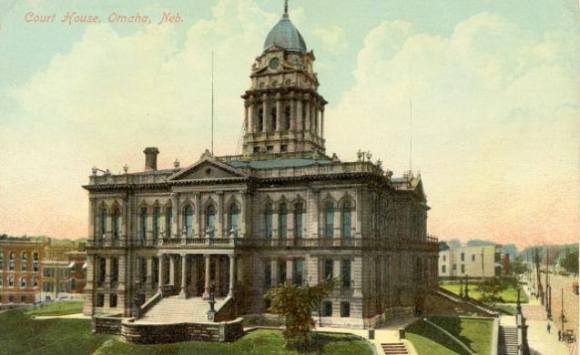
III. Tension and Terror in Omaha (1900-1920)
- 1900: Thomas Mahammitt becomes the City of Omaha Inspector of Weights and Measures.
- 1901: Thomas Mahammitt, publisher of The Enterprise, joins the executive committee of the Western Negro Press Association.
- 1902: Clarence Wigington, Omaha’s first African American architect, begins his career, eventually design the Broomfield Rowhouse, Zion Baptist Church, and the second St. John’s African Methodist Episcopal Church building, among others.
- 1902: After failing to deliver the votes Tom Dennison needed for an election, Vic Walker lost ownership of his bar. Attempting to get back at him, he began to prosecute allies of Dennison. He also filed corruption charges against police officers. Dennison had police officers Martin Shields and John Brady attack Walker on February 26. Charged with carrying a concealed weapon and resisting an officer, the officers beat Walker severely. The case against Walker was dismissed by the courts though, and believing Shields wanted to kill him, Walker took him to court. During the trial witnesses were not to be found, and Shields was found not guilty. Walker left Omaha shortly after that.
- 1903: Jack Broomfield assumes leadership of Omaha’s African-American community, controlling political and criminal activity throughout North Omaha for several years. He becomes Tom Dennison’s new Black lieutenant.
- 1905: Thomas Mahammitt’s The Enterprise 1906, rallies against a city council candidate who wished to exclude the sale of certain property to blacks in Omaha.
- 1906: Omaha’s Hose Company #12 hired the first African-American firefighters in the city.
- 1907: Thomas Mahammitt advocated for a boycott of firms who refused to serve blacks.
- 1908: African American Harrison J. Pinkett becomes the first university-trained lawyer in the State of Nebraska.
- 1908: W.E.B. DuBois visits his friend and ally Harrison Pinkett in Omaha.
- 1908: A race riot breaks out in Brownsville, Texas, after Black soldiers there are accused of attacking a white woman. Harrison Pinkett defends a group of African American soldiers at Fort Omaha accused in the 1906 Brownsville Affair.
- 1910: After a tremendous upset victory by African-American boxer Jack Johnson in Reno, Nevada, mobs of whites roamed throughout North Omaha rioting, as they did in cities across the U.S. The mobs wounded several black men in the city, killing one.
- 1910: Rowena Moore was born. She was a union and civic activist, and founder of the Malcolm X Memorial Foundation.
- 1910: The City of Omaha names John Grant Pegg the Inspector of Weights and Measures, making him the first African American appointed to that position.
- 1911: Lawyer Harrison Pinkett went against Tom Dennison’s supposed city government machine by supporting Omaha’s Anti-Saloon League.
- 1912: The Omaha chapter of the National Association for the Advancement of Colored People was founded, the first NAACP chapter west of the Mississippi.
- 1914: Harrison Pinkett is heavily involved in the prosecution of black businesses in Omaha’s Midway, also called the Sporting District, which was the city’s red light district.
- 1915: The Omaha Monitor, edited and published by Rev. John Albert Williams, was established in North Omaha. It was nationally read. It ceased publication in 1929.
- 1915: The first film company owned by African Americans, the Lincoln Motion Picture Company, was founded in Omaha.
- 1916: Harrison Pinkett was a part of campaigns in 1916 to make Douglass County a dry county, again butting heads with Tom Dennison.
- 1916: George Wells Parker started helping African Americans resettle in Omaha using The Monitor newspaper to advocate and educate, and sending mailers to the South.
- 1917: George Wells Parker founded the Hamitic League of the World in Omaha, committed to black nationalism.
- 1919: Around September 1st, police raid at a downtown hotel and shoot a black bellboy named Eugene Scott. The Omaha Bee called the shooting as reckless and indiscriminate, noting it as the “crowning achievement” of a “disgraceful and incompetent” Omaha police department.
- 1919: Omaha NAACP organized a rally in protest of over 600 people against the racist reporting of Omaha newspapers, including the World-Herald.
- 1919: W.E.B. DuBois spoke at the Omaha Civic Auditorium with Mayor Ed Smith in attendance.
- 1919: William Monroe Trotter, editor of the radical Boston Guardian, spoke at Zion Baptist Church.
- 1919: Will Brown was lynched in downtown Omaha as part of the “Red Summer”. U.S. Army soldiers from Fort Omaha were called to stop the rioting. Reestablishing control and stationed in South Omaha to prevent any more mobs from forming, the troops established a temporary base in North Omaha at 24th and Lake streets to prevent any further murders of black citizens. Orders were issued that any citizen with a gun faced immediate arrest. All blacks were ordered to remain indoors.
- 1920s: National Federation of Colored Women had five chapters in North Omaha with more than 750 members
- 1920: A relatively short-lived paper was started called the New Era, established in Omaha and published until 1926 by George W. Parker.
- 1920: Harrison Pinkett works with others to form the Colored Commercial Club to help blacks in Omaha secure employment and to encourage business enterprises among African Americans.
- 1920: The Baptist minister Earl Little founded the Omaha chapter of Marcus Garvey’s Universal Negro Improvement Association.

IV. Omaha’s Emerging Civil Rights Movement (1921-1950)
- 1920: St. John AME Church built a factory for the employment of the women in the church.
- 1921: The Omaha and Council Bluffs Colored Ministerial Alliance demanded that Tom Dennison’s cabarets in the Sporting District “wherein there is unwarranted mingling of the races” be closed indefinitely.
- 1921: Harrison Pinkett hired George Wells Parker to be editor of a new Black newspaper called The New Era.
- 1922: Parker leaves The New Era and created a new paper called The Omaha Whip. Parker accused Pinkett of associating with the Omaha’s Ku Klux Klan and calling on Omahans to support Mayor James C. Dahlman and the rest of Dennison’s machine.
- 1923: Rev. John Williams, W. W. Peebles and Harrison Pinkett protest against the Omaha World-Herald publishing remarks of KKK imperial wizard Hiram Wesley Evans.
- 1925: Malcolm Little was born in Omaha. Later he took the name Malcolm X and became a significant leader in the United States.
- 1925: Bertha Calloway was born. She was the founder of Omaha’s Negro History Society and the Great Plains Black History Museum.
- 1927: The largest Negro newspaper west of the Missouri River for a period of time, the Omaha Guide, was established by B. V. and C. C. Galloway in Omaha. The paper had a circulation of over twenty-five thousand and an advertisers’ list including business firms from coast to coast.
- 1927: Dr. John Andrew Singleton, an African American dentist and civil rights activist, represents North Omaha in the Nebraska Legislature.
- 1927: Harrison Pinkett survives an attack by a man with a gun who was screaming against Pinkett’s anti-gambling efforts in Omaha.
- 1928: The first chapter National Urban League west of the Mississippi River was formed in Omaha.
- 1929: Dr. Aaron Manasses McMillan represents North Omaha in the Nebraska Legislature.
- 1930: A clandestine group started called the Knights and Daughters of Tabor in Omaha. Also known as the “Knights of Liberty”, it was a secret African-American organization whose goal was “nothing less than the destruction of slavery.”
- 1930: 1930, two men placed an iron cross covered with oil-soaked burlap and set it on fire on the lawn of African American community leader, dentist and politician Dr. John A. Singleton, DDS. John was away, but his wife and niece were there. His father, Millard Singleton, also a community leader, arrived shortly and tore down the cross in front of a large crowd.
- 1934: Thomas Mahammitt becomes the first African American to be awarded the “Silver Beaver Award” by the Boy Scouts of America.
- 1934: Thomas Mahammitt was voted Omaha’s “most distinguished Negro citizen” for his civic activities.
- 1930s: Redlining and race restrictive covenants become popular and widespread throughout North Omaha.
- 1930s: In the 1930s and 1940s African Americans were part of successful interracial organizing teams in Omaha’s meatpacking industry.
- 1938: Mildred Brown and S.E. Gilbert founded The Omaha Star.
- 1947: A group of students working with a Catholic priest start the DePorres Club. In the 1950s, the offices of the Omaha Star hosted the DePorres Club after Creighton banned them from campus. The club hosted a community center called the Omaha DePorres Center to meet the needs of low-income families. It eventually started branches in Denver and Kansas City. According to one historian, “Their goals and tactics foreshadowed the efforts of civil rights activists throughout the nation in the 1960s.”
- 1948: African American doctor Aaron McMillan opens the People’s Hospital on 20th and Grace Streets, closing it in 1953.
- 1948: At age 80, Thomas Mahammitt retired as scoutmaster of Troop 79 at Long School.
- 1949: The Omaha Urban League honors Thomas Mahammitt for his work on inter-racial co-operation.
- 1950: Whitney Young became the director of Omaha’s Urban League.

V. Explosion, Rights, and Neglect (1951-1980)
- 1952: The DePorres Club started the Omaha Bus Boycott, which lasted until 1954. Mildred Brown, a leader of the boycott, extolled readers of The Omaha Star to “Don’t ride Omaha’s buses or streetcars. If you must ride, protest by using 18 pennies.” Focusing on ending the Omaha and Council Bluffs Street Railway Company’s policy of not hiring black drivers, the boycott was successful.
- 1953: Goodwin’s Spencer Street Barbershop at 3116 N. 24th Street where young Ernie Chambers was a barber.
- 1954: the City of Omaha Fire Department was formally integrated.
- 1954: The Fair Deal Cafe opened at North 24th Street. It was regarded as the “Black City Hall”. It closed in 2003.
- 1958: Salem Baptist Church hosted Dr. Martin Luther King, Jr. in a major speaking event in Omaha.
- 1958: A group of African American educators in Omaha Public Schools started a professional caucus called Concerned and Caring Educators that continues to this day.
- 1960: Omaha’s public housing was desegregated.
- 1960: Construction began on the North Freeway. It is a physical barrier separating the African American community, undermining the businesses on 24th and 30th Streets, and is largely disregarded by North Omaha residents.
- 1962: The Black Panthers Party (BPP) starts operating in Omaha. They work with anti-poverty agencies, on a petition drive, operated a liberation school (Freedom School) for children, publish a newsletter and worked on a breakfast program.
- 1963: The Citizens Civic Committee for Civil Liberties, or 4CL, was founded in Omaha. The group rallied throughout the city to demand civil rights for all African Americans through picketing, stand-ins during city council meetings and other efforts. They set forth the formal agenda for Omaha’s civil rights movement, with three main goals to be achieved through state legislation: to ensure equal housing opportunities and equal job opportunities for African Americans, and to secure integrated schools through busing for all African American students.
- 1963: local youth activists were successful in bringing down the color barrier at Peony Park, the city’s main amusement park, after protesting at the admission gates for several weeks.
- 1963: Civil rights demonstrations in Omaha led to the creation of the Omaha Human Rights Commission. This commission was regarded as a sham by many.
- 1964: Malcolm X spoke in Omaha.
- 1963: The Black Association for Nationalism Through Unity (BANTU) was a unique Omaha youth activism group that organized African American students in the city’s high schools. Focusing on black power and self-determination, BANTU claimed concessions from the Omaha City Council, with Senator Edward R. Danner lobbying the Nebraska State Legislature on their behalf.
- 1966: In July, riots begin near 24th and Lake during the heat of the summer with no recreational activities available to local young people. Riots, including throwing firebombs and demolishing storefronts, continue for three days until the Army National Guard is called to stop it.
- 1966: In August, riots happen after police kill a 19-year-old African American who was reportedly burglarizing a house.
- 1966: The documentary film, A Time for Burning, was nominated for an Oscar. It was focused on North Omaha’s racial tensions and a young leader named Ernie Chambers.
- 1968: An integrated crowd protesting racist presidential candidate George Wallace’s speech downtown was dispersed by riot police. Fleeing crowds firebombed North Omaha businesses, turned over cars and caused other damage. Ernie Chambers is credited with stopping the riots the next day.
- 1968: Local young people Ed Poindexter was Chairman of the Omaha affiliate chapter, and college student David Rice (Mondo we Langa) became the Minister of Information of the local Black Panthers Party chapter.
- 1968: The FBI establishes COINTELPRO offices in Omaha to conduct surveillance on North Omaha’s African American political activities, with Director J. Edgar Hoover telling The New York Times the BPP was “the greatest threat to the internal security of the country.”
- 1969: Riots happen again after an Omaha Police officer shoots an unarmed African American girl named Vivian Strong in the back. Three buildings were firebombed, and 180 riot police were used to stop the riots.
- 1970: Black Panther Party leaders Mondo we Langa (formerly David Rice) and Edward Poindexter were charged and convicted of the murder of Omaha Police Officer Larry Minard with a bomb. At the time they were charged, they were leaders of the BPP’s National Committee to Combat Fascism.
- 1970: Lois Mark Stalvey’s book, The Education of a WASP, was published about Omaha’s integration efforts and brings a spotlight to the city across the U.S.
- 1971: Omaha Public Schools starts its integrated school busing program as a result of the 1971 Swann v. Charlotte-Mecklenburg Board of Education ruling enforcing Desegregation busing in the United States.
- 1976: The Negro History Society formally opened the Great Plains Black History Museum with the goal of celebrating African American contributions to the city and region.

VI. Modern Times in Omaha Politics (1981-2005)
- 1981: Fred Conley became the first African American elected to the Omaha City Council.
- 1992: Carol Woods Harris became the first African American elected to the Douglas County Board and served until 2004.
- 1996: The Logan Fontenelle Housing Projects were torn down, and by the end of the decade, all of the city’s large scale housing projects were gone.
- 2002: The City of Omaha installed the Rev. Dr. Martin Luther King Jr Cornerstone Memorial at the NW corner of 24th & Lake Streets in 2002.
- 2003: Native Omahan Thomas Warren was named the city’s first African-American Chief of Police for the Omaha Police Department.
- 2005: Ernie Chambers became the longest-serving State Senator in Nebraska history
Timeline of African American Legislators in Omaha

Did you know there have been at least 11 members of the Nebraska Legislature representing North Omaha who were and/or are African American? In my research, I have located…
- 1893–1897: Dr. Matthew Ricketts
- 1926–1928: John Andrew Singleton
- 1926-1927: Ferdinand L. Barnett
- 1929–1930: Dr. Aaron Manasses McMillan
- 1932–1935: Johnny Owen
- 1935–1941: John Adams, Jr.
- 1949–1962: John Adams, Sr.
- 1961–1970: Edward Danner
- 1970–1971: George W. Althouse
- 1971–2009, 2013–2021: Ernie Chambers
- 2009–2013: Brenda J. Council
- 2009–2017: Tanya Cook
- 2017-Present: Justin Wayne
- 2021-Present: Terrell McKinney
African American Political Patronage
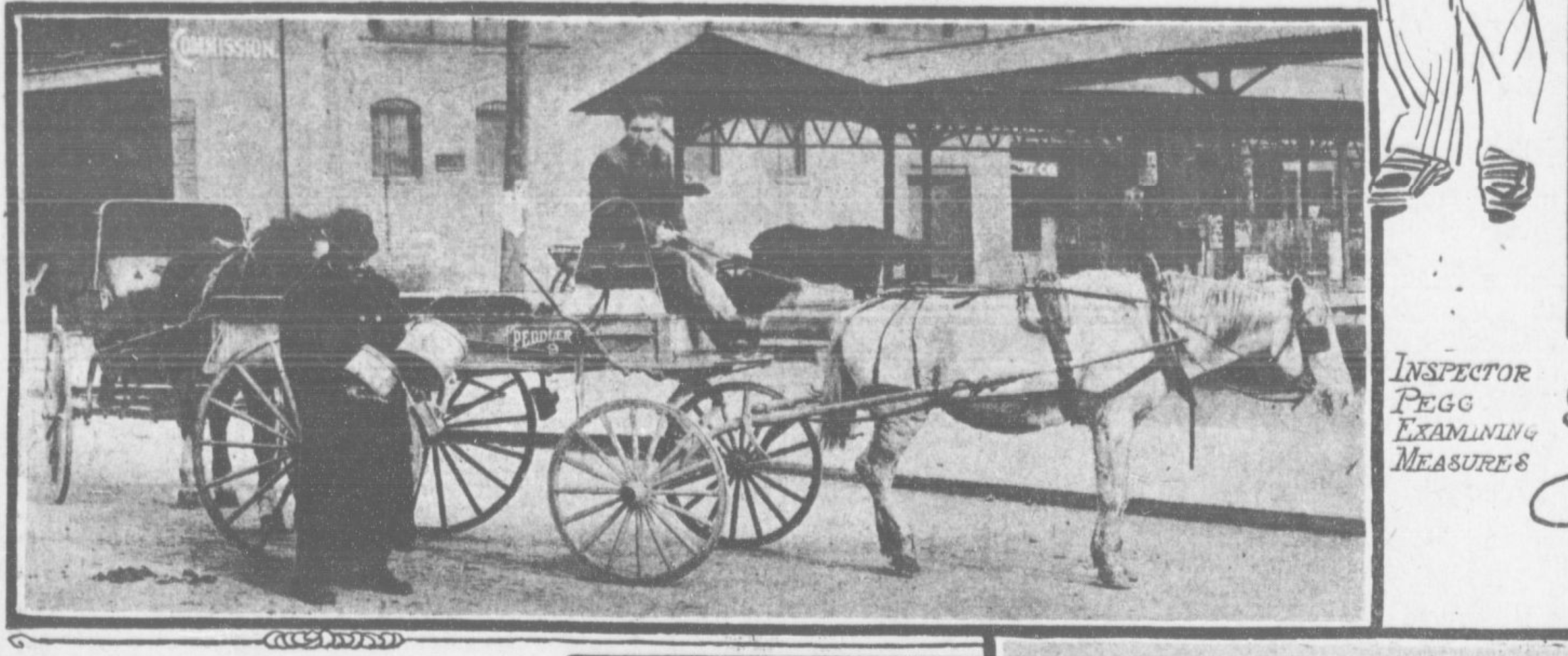
Not one to normally acknowledge Black voters, the City of Omaha did have a system of Black political patronage in effect for almost a century. In exchange for promised Black votes, for 13 appointments at their own discretion, the Omaha mayor specifically appointed African Americans to an office in the City of Omaha government.
Starting in 1890, A.W. Parker (1856-1916) was the first-ever African American to serve as the Inspector of Weights and Measures for the City of Omaha. He served under a Democratic mayor until 1892. In 1892, George F. Franklin (1856-1901) was the second-ever African American to serve as the Inspector of Weights and Measures for the City of Omaha. He served under a Republican mayor until 1896. George F. Franklin became the third African American to serve as the Inspector of Weights and Measures for the City of Omaha. He served from 1896 to 1897. Starting in 1897, John W. Long (1861-1925) was the fourth African American to serve as the Inspector of Weights and Measures for the City of Omaha. He served under a Republican mayor until 1900.
At the turn of the 20th century, Thomas Mahammitt (1862-1950) was the fifth African American to serve as the Inspector of Weights and Measures for the City of Omaha. He served under several Republican mayors from 1900 until 1910. Starting in 1910, John Grant Pegg (1856-1910) was the sixth African American to serve as the Inspector of Weights and Measures for the City of Omaha. He served under a Republican mayor until 1916.
In 1916, Amos P. Scruggs (1875-1946) was the seventh African American to serve as the Inspector of Weights and Measures for the City of Omaha. He served under a Rebpulican mayor until 1918. John W. Long was the eighth African American to serve as the Inspector of Weights and Measures for the City of Omaha. He served under a Democratic mayor from 1918 until 1921.
William S. Metcalfe (1866-1948) was the ninth African American to serve as the Inspector of Weights and Measures for the City of Omaha. He served under several Democratic mayors from 1921 until 1933. Starting in 1938, M.C. James was the tenth African American to serve as the Inspector of Weights and Measures for the City of Omaha. He served under a Republican mayor until 1935. Starting in 1935, Marcellus Ritchie (1897-1978) was the eleventh African American to serve as the Inspector of Weights and Measures for the City of Omaha. He served under a Republican mayor until 1938.
Starting in 1938, Willis W. Gray (1897-1978) was the twelfth and last-ever African American to serve as the Inspector of Weights and Measures for the City of Omaha. He served under a Democratic mayor until 1964. After Gray, African Americans have continued to receive appointments in the City of Omaha government, but none as explicitly for political patronage as this position was for so long.
What would you add? Please share your thoughts, additions, corrections and information in the comments.
You Might Like…
MY ARTICLES ABOUT CIVIL RIGHTS IN OMAHA
General: History of Racism | Timeline of Racism
Events: Juneteenth | Malcolm X Day | Congress of White and Colored Americans | George Smith Lynching | Will Brown Lynching | North Omaha Riots | Vivian Strong Murder | Jack Johnson Riot
Issues: African American Firsts in Omaha | Police Brutality | North Omaha African American Legislators | North Omaha Community Leaders | Segregated Schools | Segregated Hospitals | Segregated Hotels | Segregated Sports | Segregated Businesses | Segregated Churches | Redlining | African American Police | African American Firefighters | Lead Poisoning
People: Rev. Dr. John Albert Williams | Edwin Overall | Harrison J. Pinkett | Vic Walker | Joseph Carr | Rev. Russel Taylor | Dr. Craig Morris | Mildred Brown | Dr. John Singleton | Ernie Chambers | Malcolm X
Organizations: Omaha Colored Commercial Club | Omaha NAACP | Omaha Urban League | 4CL (Citizens Coordinating Committee for Civil Rights) | DePorres Club | Omaha Black Panthers | City Interracial Committee | Providence Hospital | American Legion | Elks Club | Prince Hall Masons | BANTU
Related: Black History | African American Firsts | A Time for Burning | Omaha KKK | Committee of 5,000
Elsewhere Online
- North Omaha History Podcast Episode 2: Early African American Leaders in Omaha – Adam Fletcher Sasse takes us back to the 19th century to let us know about Omaha’s earliest African American leaders including Silas Robbins, Dr. Matthew Ricketts, the Singleton family, John Grant Pegg and into the 20th century with Clarence Wigington and Mildred Brown. (March 7, 2017; 15 mins) Listen online or download on iTunes
- North Omaha History Podcast Episode 3: Early North Omaha Community Leaders, Part 1 – In this episode, Adam Fletcher Sasse talks about early leaders in the Omaha community, including, believe it or not, Brigham Young! Also, learn about the founders of Florence, Saratoga, and Sulphur Springs, as well as the Kountze brothers. (March 7, 2017; 14 mins). Listen online or download on iTunes
Bonus Pics!




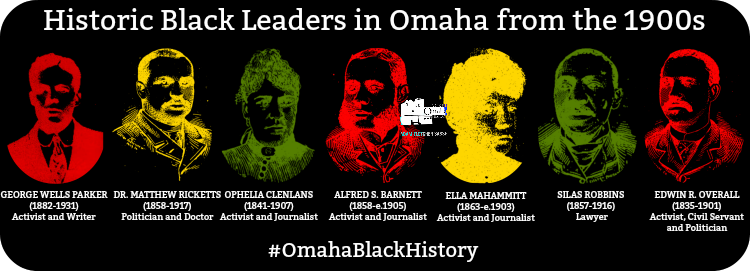
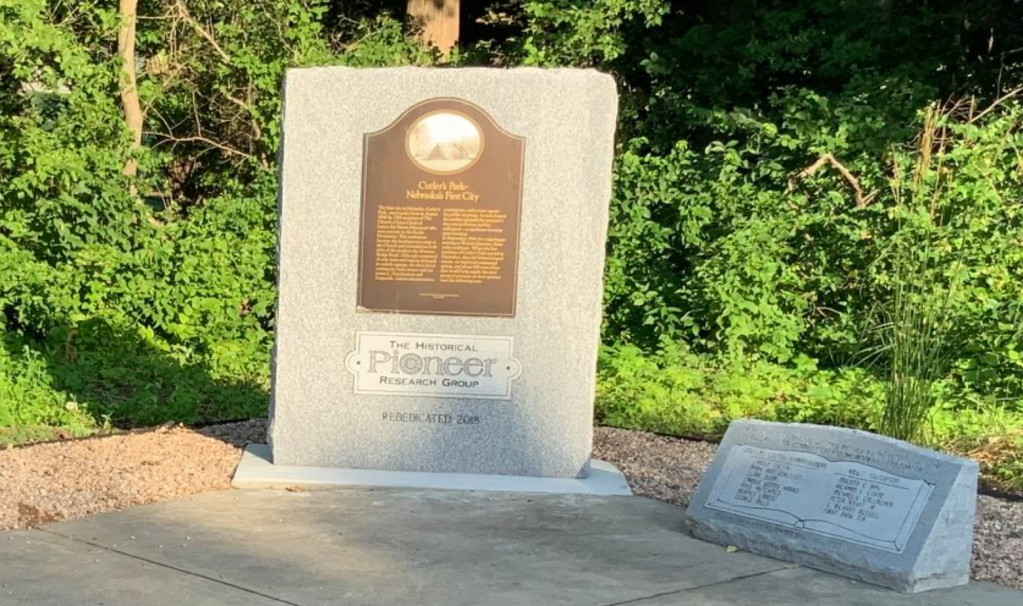
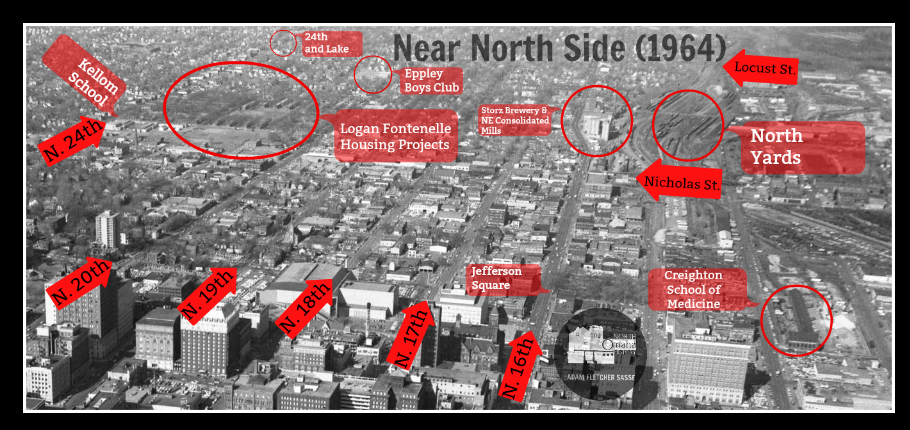

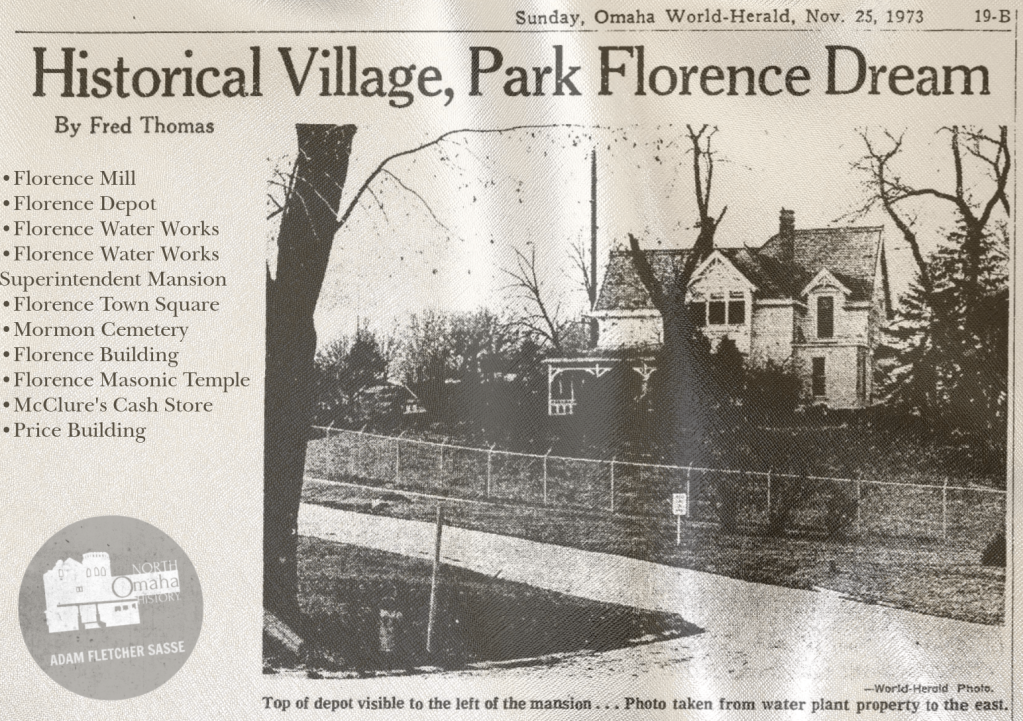
Leave a comment